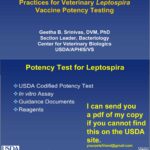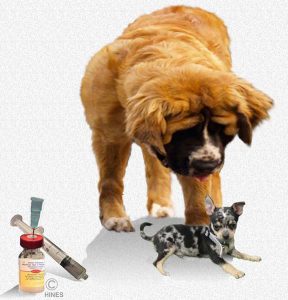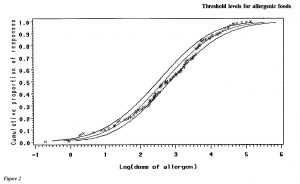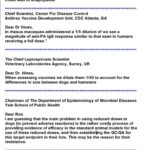One Size Fits All?
Is One Size Leptospirosis Vaccine Dose Really Right For All Dogs?
Ron Hines DVM PhD
 Anaphylactic (Shock) Reactions In Your Dog
Anaphylactic (Shock) Reactions In Your Dog
 A Science-Based Vaccination Schedule For Your Dog
A Science-Based Vaccination Schedule For Your Dog
 Dog Owner Experiences With Leptospirosis-Containing Vaccines
Dog Owner Experiences With Leptospirosis-Containing Vaccines
 The Most Likely Places For Your Dog To Be Exposed
The Most Likely Places For Your Dog To Be Exposed
The short answer is no. What comes in the vial is a manufacturer’s compromise for convenience – enough to immunize the largest dog, but far too much for the smaller ones. RSH
For most people this is a difficult article to understand. It is long-winded and technical. If anything remains unclear, you can always send me an email, and I’ll do my best to guide you through it. I removed most of the full-length scientific PDF articles that once accompanied this page to save server space. If you ask me for them, I will happily provide them to you.
Over the years I receive many more vaccine reaction emails from dog owners than anyone would wish for. Recently two dog owners wrote to me to express their grief at loosing their dogs subsequent to receiving leptospirosis vaccine booster shots. That is what motivated me to write this article. Physicians and veterinarians have long known that leptospirosis-containing vaccines are among the most likely to give unwanted and unanticipated vaccine reactions. (read here & here) It troubles me so when grieving dog owners ask me why these leptospirosis-containing dog vaccines are so intensely marketed. But even more so that inappropriately large leptospirosis antigen doses are routinely given to little dogs. As far as the vaccine manufacturers are concerned, one size fits all.
When I began writing this page, a friend of mine in Connecticut had recently run into serious legal issues while trying to protect his client’s smaller dogs from excessively large and often totally unnecessary booster vaccinations:  Too much compassion for animals can have its legal consequences. Later that month, I read an AVMA quote from a Department of Agriculture’s dog and cat APHIS vaccine regulator describe vaccine manufacturers as his “clients”. How strange, I thought that their clients were pet owner owners and their pets:
Too much compassion for animals can have its legal consequences. Later that month, I read an AVMA quote from a Department of Agriculture’s dog and cat APHIS vaccine regulator describe vaccine manufacturers as his “clients”. How strange, I thought that their clients were pet owner owners and their pets:
 Another sign that the time had come to have a closer look at this whole sordid situation.
Another sign that the time had come to have a closer look at this whole sordid situation.
The last East Coast client’s dog with a severe vaccination reaction had received Merial’s Recombitek® 4LEPTO. So, I called the Merial veterinarian’s hotline. The pleasant young veterinarian who answered seemed to know little more about the frequency of vaccine reactions than I did. The vaccine safety studies that the Merial website promos and product labels referred to and that she promised to send me never arrived. Another dog with a fatal vaccination reaction belonged to a US servicewoman stationed in Japan who had written me. It had received Merck’s Nobivac ® Lepto 4 vaccine. My attempts at obtaining vaccine reaction data on that product from Merck were equally unsuccessful.
So, I called the veterinarian’s inquiry line at the USDA Center For Veterinary Biologics (CVB) in Ames, Iowa. Their Biologics Specialist, a PhD in Molecular Biology, was uninformative, condescending and moderately hostile. Not only would he not discuss vaccine reactions with me, he told me that all adverse events (bad reactions) reports that the CVB receives from the public and veterinarians alike become “proprietary” – property of the vaccine manufacturers, and I was not allowed to see them. So, I asked to view the initial safety studies submitted to the CVB when the vaccines were initially approved. He refused that as well and chuckled that any attempts I might make to obtain additional information under The Freedom of Information Act (read here) would be unsuccessful as well. He was wrong.
Dog owners like you are in a unique situation when it comes to your pet’s vaccine safety and efficacy. Although all human vaccines are reviewed for safety and efficacy by the FDA; all animal vaccines are supposed to be reviewed for their safety and efficacy by the US Department of agriculture under an archaic law, The Virus-Serum and Toxin Act of 1913. That law was enacted because of some worthless pig vaccines that came on the pork producer’s market. You can see any bad reaction reports on the vaccines you and your family receive anytime. The FDA posts all of them that they or the manufacturers receive online. But you are not allowed to see the same information when it comes to your dog or cat.
Over the years, the veterinary establishment (AVMA), comfortably insulated from reality in Schaumburg, IL, has developed an inflexible, pyramidal structure – much like the old monarchies of Europe. Their official position is that vaccine dose has nothing to do with bad (“adverse events”) reactions. The one-size-fits-all vaccine dogma reigns supreme there, and it is considered heresy to question it.
First I decided to write to the most knowledgeable person I knew of regarding vaccines, Dr. Plotkin to ask him his thoughts. Dr. Plotkin replied that my “perception that there were no studies that addressed the question [of proper dose size scaled to body weight] was correct”. He went on to write that most human beings at specific ages just do not differ enough in weight for those types of studies to have been a priority. He acknowledged that that most certainly was not the case in dogs.
What Happens After My Dog Receives A Leptospirosis-Containing Vaccination?
I sometimes use the word vaccine and antigen (really its active ingredient) interchangeably. When I say “antigen mass” I mean the amount of antigen in the vaccine dose. But although the primary ingredient in all vaccines are antigens, most vaccines contain other ingredients, either required in their manufacture (such as various blood and meat extracts, BSA, etc. or things added to increase the product’s ability to stimulate your dog’s immune system (adjuvants). They are not without risk. (read here)
As I write, there are 8 leptospirosis-containing vaccines on the market in the United States. All but one combine the leptospirosis part (a dead antigen) with attenuated (weakened) live virus antigens (a modified live virus or MLV) designed to protect your dog against several common canine diseases (a “multivalent” vaccine). How your dog’s body reacts to dead (inactivated, killed) antigens like the leptospirosis part and how it reacts to the live MLV antigens are quite different. When a killed products like ground up, dead leptospirosis is given, all the antigen your dog is going to get is in the syringe. When an MLV vaccine is given, the weakened but live virus multiplies within your dog producing much more antigen than what was in the syringe. To gain any benefit from the lepto portion, there has to be a large amount of that antigen in the syringe.
In the case of modified live virus vaccines, like those against canine distemper or parvovirus, only enough organisms (antigen mass) need be given to assure that the virus multiply in your pet’s body and that the resulting (very mild “asymptomatic”) infection produces protective antibodies, and more importantly immunological memory. Immunological memory is what will protect your pet into the future – long after the amount of antibody in its blood stream has declined. In the second type (killed antigen vaccines or bacterins) like leptospirosis, Lyme vaccine and rabies vaccine, veterinarians count on the mass (the quantity) of dead antigens in the syringe to produce the antibodies and hopefully an immunological memory that will protect your pet in the future. It is common for the immunity imparted by MLV vaccines to be considerably greater and to last much longer than the immunity produced by killed products like leptospirosis.
Within an hour or so of receiving the shot, the killed lepto antigens in the vaccine will be carried through your pet’s local lymphatic vessels to your dog’s lymph nodes nearest to the injection site. The courier cells that carry the antigens are called dendritic cells – sentinel guarding cells of your pet’s immune system that are scattered throughout its body. Dendritic cells are particularly common under the surface of your dog’s skin, nose, lungs and intestine – the places where invading bacteria and virus are most likely to try to enter its body.
As best, we understand it, dendritic cells probably form from monocytes. Dendritic cells deliver (“present”) the antigen in vaccines to another type of lymph node cell, the virgin (“naive”) T-cells (CD4+ T cells), along with orders to begin dividing and to produce peptides and combine them with MHCII molecules. The peptide-MHCII complexes will stimulate your pet’s CD4+ T cells to divide (proliferate) to their Th1, activated form. Others will become cells (Tfh or T-follicle helper cells) that assist certain B-lymphocytes (aka plasma cells) in your pet’s lymph nodes in producing antibodies against the vaccine antigens that were injected. One thing we do know for sure is that if this choreographed “dance of the cells” does not go precisely as ordered, your dog will not become immune, or your pet will produce antibodies that are not in the best interest of its short-term or long-term health. That is why over-vaccination is best avoided.
Here is the critical problem:
If your smaller dog gets a whopping dose of leptospirosis antigen through a vaccination – more than its regional lymph nodes can process (opsonize) – what becomes of the excess? Is the excess antigen toxic? With lepto, certainly so. (read here) Might it cause anaphylactic shock? Possibly, if the dog’s immune system was primed by a prior leptospirosis vaccination or natural exposure to the organism. Might a superfluous vaccination actually decrease the dog’s long term immunological memory? No one knows. Will this excess antigen affect the dog’s liver, kidneys or other organs? Possibly so. (read here, here & here) Vaccine manufacturers and the AVMA would prefer that you not ask those questions. They are also unwilling to run the studies that would answer those questions or the ones that would determine the optimal leptospirosis vaccine dose size for your dog’s body weight.
How Frequently Do Leptospirosis Vaccine Side Effects Occur, And What Is In These Vaccines That Cause Them To Have So Many Side Effects?
A vaccine’s potential for undesirable side effects is sometimes called its potential for “reactogenicity”. My calls and emails to the USDA Center for Biologics in Ames, IA and Boehringer Ingelheim/Merial were an attempt to get that answered for you. Neither would cooperate in providing the information that I know that they have on file. The European veterinary regulatory agency was similarly tight-lipped. Some years ago I managed to get a few bad reaction reports from the USDA by filling a Freedom of Information Request. None of the reports were sufficiently detailed to be of any value and brand names had all been blacked out. Later I received an email from the Center For Veterinary Biologics informing me that they planned to change their policy in the future to require vaccine manufacturers to report all undesirable (adverse) vaccine reactions to them – as well as make that data easily accessible online to the public. As of 2021, they still have not done so. Much of their budget are fees charged to the vaccine manufacturers, and they are not about to bite the hand that feeds them. The pharmaceutical companies fear transparency. They have an army of lobbyists in Washington to protect their interests. But there is no one there lobbying for you or your pet’s interest. If one brand of vaccine causes more problems than another or if one vaccination method is safer than another is something they never intend to reveal to you. Experience in human medicine shows that only about 1% of human adverse events get reported to the FDA. The number of dog and cat vaccine reactions that get reported to CVB is likely only a fraction of 1%. If you report an adverse vaccine event to the vaccine manufacturer, there is no requirement that they pass on that information to the USDA/CVB.
I believe that the leptospirosis organism’s own surface proteins used to make the vaccine (the LPS lipopolysaccharides antigens) have the potential to cause adverse reactions in dogs on their own accord. If enhancing ingredients in the vaccine were responsible, the problem would have been corrected long ago – although those enhancing ingredients do have their own potential for causing harm. (read here) Lipopolysaccharides are reactogenic in their own right. (read here) Because of the anti-disclosure practices of the CVB and the vaccine manufacturers, I cannot tell you how much they contribute to the problem.
Is The Dynamics Of Every Bad Vaccine Reaction Pretty Much The Same?
No, things can go wrong in multiple ways.
First, all vaccine antigens have their own characteristics that govern how your pet’s immune system handles them. Some, like leptospirosis antigen are highly “reactogenic” (inclined to cause unwanted reactions) some are considerably less so. Second, there are many places along the immunity road where the process can take a wrong turn and producing the wrong type of antibodies (IgE antibody-class switching, promiscuous antibodies, etc.) IgE is the class of antibodies that are usually associated with allergy, hypersensitivity and anaphylactic shock. But in some cases, adverse reactions occur in the absence of circulating IgE antibody. The process is extremely complex and much has yet to be learned.
The likelihood of bad reactions in dogs increases with “booster” vaccinations because the dog’s memory cells (primed by the dog’s initial puppy shot series) are then taking part in the process as well. The focus points where these unwanted reactions occur also vary. In some dogs, their skin and underlying tissue is the primary focus point – those dogs develop hives, swelling and itching (sometimes with fever). These signs usually pass leaving no permanent damage. But they should be warning enough never to repeat those vaccinations. In other dogs, lung tissue is the central point of the reaction – when it is, their ability to breathe is affected. In others, their cardiovascular system loses its ability to sustain vital functions. That can lead to circulatory collapse (=shock) so it is by far the most dangerous type of all.
Complicating our understanding is the fact that these are often fleeting, emergency situations where dynamics change from second to second. Some are certainly due to non-key components (bovine albumen, antibiotic additives like neomycin thickening and syringability (flow enhancing) agents such as gelatin, and adjuvants designed to aid in the antigen presentation process). What percentage, I cannot say. Many factors you might not even consider can enter into the effectiveness of vaccines. Overweight children were found to respond poorly to DTP vaccinations. That problem was solved using longer needles (fat does not have an adequate lymph supply to get the vaccine’s antigens to the child’s lymph nodes efficiently). Perhaps similar things occur in chubby dogs. No one really knows.
Can You Tell Me More About The Life Threatening Vaccine Reactions – The Ones Called Anaphylaxis?
Your dog’s immune system has a group of “first responder” cells, mast cells. Mast cells are designed to release “alarm chemicals” (cytokines, histamines, etc.) whenever they detect a specific foreign protein antigens that your dog’s immune system had encountered in the past. It is a form of non-specific “chemical warfare” to hopefully destroy invaders. Basophils in your dog’s blood perform similar functions. They both wear a coat of plasma cell-generated IgE antibody on their surface (FceRI receptors) that is designed to be triggered by only one specific foreign antigen that your dog or cat encountered some time in the past. You might think of them as the biological equivalent of the naval mines pictured above. Systems like these exist in Nature to fulfill a need – not to cause problems. It is vital that you and I and your pet produce these forms of antibody-coated mast cells and basophils. Without them, we would be overwhelmed by by bacteria, virus and parasitic invaders. (read here) However the dendritic cells that scour the body looking for things that shouldn’t be there and the plasma cells they present them to occasionally make mistakes that result in some mast cells and basophils being coated with an IgE antibody engineered to react against something harmless. That is essentially what occurs in all allergies. Anaphylaxis is simply a violent and dangerous form of allergy. In us humans, that violent reaction in which mast cells degranulate could be caused by something as harmless as a peanut or a single bee sting. In dogs, something as harmless as fragments of dead leptospirosis organisms or another ingredient in a vaccine.
The cytokines and histamines that these cells release upon degranulation cause blood vessels in the dog’s body to expand (dilate) and leak fluid (angioedema). When that happens your pet’s blood pressure can drop dangerously low and its lungs can become critically congested with leaking blood plasma (pulmonary edema). You can read a much more scientific and detailed explanation of anaphylaxis here.
Veterinarians and physicians call some of these cases “anaphylactoid” reactions. The symptoms are indistinguishable from the true anaphylaxis I just described, but they occur subsequent to what the veterinarian or physician thinks was the patient’s first encounter with the allergen. True anaphylaxis never occurs on the first encounter because there is no specific IgE generated yet. We do not know which of the two are most likely to occur after a pet’s vaccination. An adverse event occurring the first time a dog receives a specific vaccine might most likely be anaphylactoid while one occurring after booster vaccinations, true anaphylaxis. But there are other ways your pet could be primed for true anaphylaxis on its first leptospirosis vaccination. Unlike most things your dog gets vaccinated against, there are over 200 species of leptospira. And of them, only 6 are known to cause disease in dogs. Warm, damp, humid environments – particularly near water impoundments, are full of non-pathogenic leptospira (= harmless and saprophytic leptospira). Perhaps association with them pre-sensitize certain dogs. We do not know. Perhaps your dog already recovered from a mild case of leptospirosis that left traces of IgE. Perhaps it was vaccinated without your knowledge. Perhaps it harbors cross-reactive (promiscuous) antibodies. (read here) Perhaps the dose size was so large that the pet’s immune system fail-safes were overwhelmed. When it was verified to be your pet’s first exposure to a leptospirosis-containing vaccine or any vaccine, it might be more accurate to just call the bad reaction a cytokine storm.
Is It True That All Size Dogs Should Be Given The Same Size Vaccine Dose Regardless Of Their Weight And Size? That Just Doesn’t Sound Logical To Me.
Veterinarians are taught to believe that in school. That is because this notion is perpetuated by the global veterinary vaccine industry and their obliging partners at the Department of Agriculture, federal bureaucrats and the AVMA. They would never get away with that if dog and cat vaccines were regulated by the FDA as yours are.The veterinary vaccine manufacturers lobby forcefully in Washington D.C. to make sure that never happens. Instead, as far as your dog and cat’s vaccines and welfare are concerned, your pets remain livestock – no different from the cows, pigs and chickens the USDA regulates on the farm, or on their way to the abattoir. So decisions on vaccine safety and dose size are subject to considerably less contemplation and scrutiny than those you yourself receive. This is despite the fact that all modern science indicates that dogs are likely to do considerably better when their vaccine dose is tailored to their specific size. It is even quite likely that body size-tailored doses give your dog stronger and longer lasting immunity than one-size-fits all. Excessive vaccine antigen can overwhelm the immune system. (read here & why here)
I have to reach far from your neighborhood dog and cat hospital into the Animal Kingdom to show you examples of why that has been found to be true.
I do that because vaccine dose size studies in dogs and cats have never been performed. When I cross species lines, it is true that the size-versus-dose relationship could be questioned. But at the least, consider them proof of concept and keep in mind that the immune systems of all mammals are quite similar in their basic mechanisms.
All vaccines used in humans today relied on cross-species tests when their effectiveness and safety were first established. The list is a long one. That point needed to be emphasized because the industry pushes back hard against it. Giving the proper amount of vaccine in proportion to body weight is called dose scaling or allometric scaling. It doesn’t come up frequently across the discussions of human or livestock vaccines because domestic dogs are the only species on the planet whose adult body weight varies in such an extreme way that it becomes important. Here are some examples:
Rabies Vaccine
Like leptospirosis vaccines, all rabies vaccines are also killed (inactivated) products. That means that they rely on the amount of rabies antigen protein in the syringe injection that your dog receives to impart protective immunity to your pet. Some years ago, the CDC worked out a procedure to vaccinating bats against rabies using a dog rabies vaccine:
Let’s look at a gray wolf. It is probably about the size of the ancient progenitors of all dogs. An adult wolf weighs about 36,000 grams (79 lbs). An Egyptian fruit bat weights about 125 grams (0.28 lbs) and a Mexican free-tailed bat 11–14 grams (0.03 lbs). Is the same 1 ml dose of dog rabies vaccine required to immunize the bats effectively? No. Fruit bats were successfully immunized with 0.1 ml of the dog vaccine and free-tail bats were successfully immunized with 0.05 ml of the dog vaccine. Read the studies here and here. (The CDC considers ≥ 0.5 IU/mL of antibody to be protective in all animals.) Rabbits weighing abut 4.8 kg (10.6 lb) are successfully immunized against rabies with a 0.25 ml dose of dog rabies vaccine. (read here) The One-Size-Dose-Fits-All theory that the vaccine manufactures the CVB and the AVMA promote certainly didn’t work there.
Mature Ringling Bros. Circus elephants weighed between 1,645 and 4,741 kg (3,627 – 10,452 lbs). It took two 4 ml doses of cow rabies vaccine to immunize them against rabies. Even that massive dose was insufficient to reliably sustain ≥ 0.5 IU/mL antibody titers, (read here) The need for larger vaccine doses in heavy animals like elephants versus lighter weight animals has been known by zoo veterinarians for over 60 years. Since no commercial elephant vaccines exist, horse or cattle vaccines are given to elephants at 2–3 times the amount suggested for horses and cattle. The One-Size-Dose-Fits-All theory that the vaccine manufactures the CVB and the AVMA preach certainly doesn’t work there either.
Our Feathered Friends
Birds are not mammals. But birds get the flu too. When the veterinarians at the Rotterdam Zoo were concerned that their birds might catch it (avian influenza H7N1), they gave them all a bird flu vaccine designed for chickens. The chicken dose was 0.5 ml. They found that there was an inverse relationship between the bird’s weight and the protection the vaccine gave. The larger birds were less protected. So subsequently, birds weighing 1.5 kg (3.3 lbs) or less received 0.25 ml of the chicken flu vaccine and birds weighing more than 1.5 kg received 0.5 ml. However, even that larger dose was not sufficient to produce antibody protection in their heaviest birds – ostriches, rheas and cassowaries. You can read about that here, here and here. Another failure of the One-Size-Dose-Fits-All theory.
How About When My Kids Or I Go In For Our Vaccinations?
The most problematic vaccine that your children get are their DTP shots. Anaphylactic reactions to DTP vaccinations are very rare – but fever, malaise and injection-site inflammation are quite common – particularly after the kid’s immune systems are sensitized (primed) by earlier DTP injections. (read here) Like leptospirosis, DTP vaccine is a killed antigen product, designed to protect children against diphtheria, pertussis (whooping cough) and tetanus. Unlike dogs, at the ages children receive these shots their weight is relatively the same, so one-size-fits-all dose size works pretty well for them. In the case of DTP, the quantity of vaccine antigen (antigen mass) your children receives definitely does influence the frequency of adverse reactions. Studies have shown that children receiving half the suggested vaccine dose for their last vaccination develop adequate protection to this disease with significantly fewer side effects. (read here) Your kids need those shots. None of those childhood vaccinations are the cause of autism.
Influenza
It’s flu season. If you receive Sanofi’s Fluzone® vaccine, you will find that it has three different antigen mass suggestions. If you’re a mature adult, you will get 45 µg of combined HA antigens. Your child under 3 will get 22.5 µg of combined HA antigens and senior citizens will get 180 combined HA antigens because elderly immune systems are less efficient at producing antibodies against the flu. Those suggestions are because Sanofi’s clinical trials found that a One-Size-Dose-Fits-All approach did not work for them either.
Americans are rarely vaccinated any more for tuberculosis. But in areas of the world where that vaccine (BCG) is routinely given, the dose for a small child is half the dose given to an older child or adult.
What Can We Learn From Bioterrorism Research?
My best veterinary technician, Tanya, move to the Washington D.C area. So, I put her in touch with old friends at the NIH. She was quickly hired for anti-germ warfare projects and emailed me that she was being immunized against anthrax – with a killed antigen product not unlike the leptospirosis vaccine. But to test their anthrax vaccine for safety and efficacy, prior to its stockpiling for use in humans, the researchers gave the vaccine to rhesus monkeys.
Adult rhesus monkeys weight 2.3-3 kg (5-7 lbs). Pharmaceutical companies often use 54.5-68 kg (120-150 lb) as the average adult human weight. The anthrax vaccine developers gave various groups of monkeys anthrax vaccine at various doses to see what protection it afforded before the monkeys were later infected with living pathogenic anthrax. In this small study, more monkeys survived anthrax when they had been immunized with half the human vaccine dose than with the full human vaccine dose (100% survival vs 80% survival). Protocols were then modified so that today, all rhesus monkeys receive one-fifth the human dose. That is another hint that too large a vaccine antigen dose might actually give your dog less protection against leptospirosis than an appropriately smaller dose based on your dog’s actual body weight. (read here) Those results reminded me of the early experiment I mentioned where smaller vaccine doses produced better immunity against rabies in monkeys than a larger one. At the time, the authors theorized that the full human dose was too large for the smaller monkey’s immune system to effectively handle. (read here) Two more One-Size-Dose-Fits-All theory failures.
Developing A Vaccine Often Begins In Mice
NIH invests a great deal of money and effort looking for effective vaccines to prevent human AIDS. . One promising approach is to link AIDS virus antigen components to a harmless adenovirus vector – something similar to Boehringer Ingelheim/Merial’s canarypox-vectored feline leukemia vaccine. Those researchers have found that the response in mice is better when the dose is reduced by 1–3 logs versus what they use in their human volunteers (a 1 log reduction is a ten times smaller antigen mass, a 3 log reduction is 1000 times smaller amount of antigen). Another confirmation that vaccine doses need to be scaled to a specific animal’s body weight.
What Can Ten Hamsters Tell Us?
They can tell us two things. They can tell us if a particular batch of leptospirosis vaccine is “up to snuff” ; that is if it meets quality control regulations and if they could talk they would tell you that an effective leptospirosis immunizing dose has to fit their body weight. You probably thought that all sorts of sophisticated analytical machines were used to test the potency of your dog’s next dose of leptospirosis vaccine – right? Actually, each batch of leptospirosis vaccine relies on ten hamster “volunteers” for a dangerous assignment. Every year more than 32,000 hamsters do so: 
These hamsters all weigh between 50 and 90 grams. Five of the hamsters are immunized with a specific brand of dog leptospirosis vaccine and five are not. Fifteen to 20 days later, all hamsters are given a potentially fatal dose of living leptospira. At lease four of the five unimmunized hamsters must die and four out of five vaccinated hamsters must live, before the vaccine batch can pass quality control. Now according to the vaccine manufacturers, the AVMA and the USDA position, you would think that all the immunized hamsters would receive the same vaccine antigen dose that they suggest for dogs since all three say that dose size doesn’t need to be scaled to body weight. However, that isn’t what they do. The immunized hamsters receive 1/40th of the recommended dog dose. Testing procedures for European dog leptospirosis vaccines are essentially the same as in the USA. If you want the articles on which this paragraph is based, send me an email. Hamster batch-testing does not tell you if one batch of vaccine is more reactogenic (prone to bad reactions) than another. For that, you would need something like a post-vaccination febrile (fever) test in dogs. I do not know if they bother to run them. But if they did, one could choose the least reactogenic brand of leptospirosis vaccine, should you choose to vaccinate your dog against leptospirosis.
I can’t tell dog owners like you or or veterinarians to scale their dog’s leptospirosis vaccine dose size to their pet’s body weight. That is illegal. Until we have hard data release (if ever) that will be a decision that you and your personal veterinarian have to make on your own. Some veterinarians in Japan feel the same way I do and have gone much farther in doing the research that we should be doing too. (read here)
Are The Chances Of A Bad Reaction To A Vaccine A Simple Matter Of The Size Of The Dose and The Weight Of My Dog?
No.
They are not simple dose to body weight equations (not bigger dose = more reaction). They are related in a much more complicated non-linear way and can occur over a wide range of doses depending on your dog’s unique genetics, environment and lifestyle. Another non-linear event is the weather. If you get up for work and find an overcast sky, you are more likely to take your umbrella with you because you anticipate the possibility of rain. It may rain, and it may not rain – but you know the chances are greater than on a sunny day.
Well, Presumed Experts Know That Anaphylactic Reactions Are An All-Or-Nothing Event – So It Wouldn’t Make A Bad Reaction Any Less Likely If My Pet Got A Smaller Vaccine Dose – Right?
Not so.
First, we do not know the true nature of post-vaccination reactions in dogs. They might be classic anaphylactic events that follow traditional explanations, or they might be anaphylactoid reactions that do not. Most likely many different types of bad reactions are lumped together in one bundle if the visuals and outcomes are similar. They occur as crisis situations in animal hospitals, not in some white-coat laboratory staffed by bench scientists.
Regarding anaphylaxis, it is true that there is a triggering dose (a threshold dose) that will cause reactions. In very sensitive pets, those whose mast cells are highly primed, it can be so small an antigen dose that it could be described as “any dose”. But that is not strictly speaking correct. Some believe that the greater the dose, the more likely those events are to occur and, possibly, the more violent they will be. Those dynamics of anaphylaxis are rarely studies. But it was examined with regard to anaphylaxis-triggering antigens such as peanuts that enter through the digestive system. (read here) The graph below taken from that article shows that the larger the dose exposure to those antigens was, the more likely an allergic or anaphylactic event was to occur.
The Center For Veterinary Biologics (CVB)
When you receive a vaccination, the folks at the FDA’s (CBER) unit in White Oak, MD look out for your safety. Reaching back to 2012, The CBER had a key professional staff of about 179 individuals. Its 2018 budget was $358 million dollars. However, your pets are not as fortunate. All vaccines intended for animals are approved and supposedly monitored for safety by the US Department of Agriculture’s Center For Veterinary Biologics in Ames, Iowa. The CVB had a professional staff of less than 39 individuals in 2013. It’s 2018 budget was only $16 million dollars – supplemented by hefty fees collected from the same vaccine manufacturers they regulate (never a good thing). The average starting salary for an FDA/CBER employee was then estimated to be $91,000. But in the same year the average starting salary for a USDA/CVB employee was estimated to be $49,000. Do you have a problem understanding why the CBER does a better job of protecting you than the CVB does at protecting your dog and cat?
The CVB staff that approves and monitor’s your pet’s vaccines are well-meaning, honest people. But their current employment and hope of future advancement depends to a large part, on staying in the good graces of the vaccine companies that fund them and their lobbyists in Washington who lobby intensely for those pharmaceutical companies’ interests. Situations like that are ripe for gaming and misuse. Even the mighty FDA itself has to deal with it day in and day out. (read here, here & here) The FDA and USDA also have entirely different philosophies when it comes to vaccine safety. The USDA/CVB’s focus has always been on agriculture where a cow’s value is a fixed and moderate amount, emotional attachment to the animal is minimal and a higher degree of adverse events is considered acceptable.
Every fall, the powerful lobbying group of veterinary vaccine manufacturers, the Association of Veterinary Biologics Companies (AVBC), migrates to the USDA/CVB facility in Ames, Iowa from their roost in McLean, VA – like crows at corn harvest. It is highly unrealistic to expect the little group of Ames, Iowa mid-westerners at the CVB – no matter how dedicated and well-meaning they might be – to protect the interests of pet owners like you across the Nation when faced with a multi-billion dollar veterinary drug industry intent on driving profits to the max (33+ billion in 2019). They hear from plenty of lobbyists and industry spokesmen, but they don’t get many letters of thanks or protection from dog owners like you. As things now stand, the CVB has been reduced to an impotent lady’s auxiliary to the veterinary vaccine industry.
Inappropriate Selection Of Vaccine Test Dogs
Although the USDA/CVB did not utter a peep, the beagle dogs, used to document the safety of canine leptospirosis vaccines were too young to document the safety of the vaccine when administered to the adult dogs that are the majority that receive it. CVB would not share their data with me. But as an example, the MSD (aka Merck) leptospirosis vaccine marketed in Europe, Nobivac®DHPPi, was tested in beagle puppies that were only 6–10 weeks old. Very few practicing veterinarians would inject leptospirosis-containing vaccines into a puppy that young. The immune system of a 6-10 week old puppy is too immature to be indicative of what might occur when an older dog received the vaccine. The reviewers should have known that the likelihood of reaction is much worse in a dog’s middle years when one or more booster injections have already primed the mast cell hypersensitivity (allergic reaction) system. The French contingency of Merial used 8-16 week old beagles to test their Eurican1L® canine leptospirosis vaccine.
Reviewing the data on the strains of leptospirosis that Merck tested their lepto vaccine on in Boxmeer, there was considerable room for downward antigen dose adjustment. – one quarter the recommended vaccine dose gave adequate protection to their beagle dogs. Neither the CVB nor Merial/Boehringer Ingelheim would tell me the breed, let alone the weight, of the dogs used in their CVB vaccine approval submission packet.
Can You Propose Ways That Too Large A Dose Of Leptospirosis Vaccine Might Increase The Likelihood Of Side Effects – What Do World Experts Say?
I posed the question of best vaccine dose size/ to body weight to some of the world’s leading vaccine immunologists. Read their replies here:
The accepted company line is “the cause of vaccine reactions are multifactorial” which is doublespeak for “we know these reactions occur, but we have no idea what the specific causes are. These are just a random act of nature – like being struck by lightening”. Reduced to a simple analogy, the immunity process is similar to the performance of a dance troupe – a choreographed performance between dendritic cells adorned in IgE antigen cavorting with their T-cell gentlemen – while memory B cells keep a record of the performance to play it again at some later date. I believe that excessive amounts of vaccine antigens – particularly when given repeatedly make it more likely that the situation will go out of control – to a point where inappropriate antibodies (class switching) and memory cells are produced. Rather than my fanciful explanation, you can read a scientific explanation about the true processes that likely occur here. (fig.4)
Are You One Of Those Anti-vaccination-Fixated Or Conspiracy Guys?
I am not at all against vaccines and vaccination. Appropriately timed puppy and kitten vaccinations are critical to your pet’s future wellbeing. Our dogs and cats need them – but in the right amounts and at the right times in their lives. (read here) Vaccines and antibiotics are the two greatest health discoveries of the modern age. I just believe that we owe it to our dogs and cats to administer vaccines in accordance with current scientific knowledge and that old practices need to be periodically reviewed in light of advances in our understanding of immunology. I also believe that a drag on veterinary vaccination reform is the reckless pursuit of money that has replaced honesty in many facets of American life.
What Should I Do When I Get A Postcard, Phone Call or Email That It’s Time For My Adult Dog’s Booster Vaccinations?
Tell your veterinarians that you love and appreciate them. But avoid succumbing to pressure to agree to vaccinations that are unnecessary. Agree to a blood antibody titer test if you like, but realize that immunological memory, the most important thing, is not measured by titer tests. The current dynamics of veterinary medicine heavily encourage over-vaccination. Revenue enhancement recommendations are never made in a vacuum. Veterinarians are caught in an economic squeeze: National policies encourage an abundance of new graduates with relatively low starting salaries – barely enough to pay off their sizable college loans.
 Candy bar corporations squeeze out or convert idealistic young vets who are less motivated by economics. CPAs in these veterinary conglomerates closely scrutinize the average client bills of each of them with a jaundiced eye.
Candy bar corporations squeeze out or convert idealistic young vets who are less motivated by economics. CPAs in these veterinary conglomerates closely scrutinize the average client bills of each of them with a jaundiced eye.
Vaccination buses cruse the Country indiscriminately pushing their vaccine wares and pediatric neutering.
I prefer not give multivalent (prevents more than one disease) vaccines to your dog when single disease products are available. Let your dog’s immune system focus on one antigen at a time when that is an option. There is no beneficial effect in giving combination vaccines and there can be detrimental effects – particularly when they contain known reactogenic ingredients such as leptospirosis antigens. The only benefit of 4-way and 5-way vaccines is convenience. Besides, if your dog gets multiple disease (polyvalent/multivalent) products and has a reaction, you won’t know which of the disease ingredients was the cause of it. The same goes for giving a rabies shot and other shots during the same office visit. Those multiple “4-way & 5-way” vaccines containing leptospirosis as one of their ingredients have the potential to cause immunosuppression whereby less protection is given against multiple diseases. (read here) It can be confusing to pet owners, some companies use the term “4-way” to describe vaccines, containing only leptospirosis but with ingredients from the four different common strains (serovars) of the organism. Be extra cautious if littermates, parents or dogs in your pet’s family tree have ever had vaccine reactions or hives subsequent to vaccinations. If your dog has a vaccine reaction of any sort, write and store the information as to the type of vaccine and brand. Avoid those brands in the future and consider if the possible benefits of future vaccinations really outweigh the risks.
You are on the Vetspace animal health website
Visiting the products that you see displayed on this website help pay the cost of keeping these articles on the Internet.








